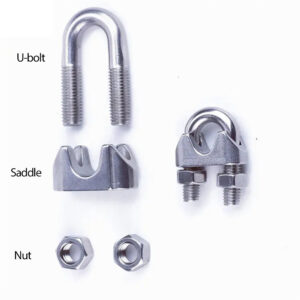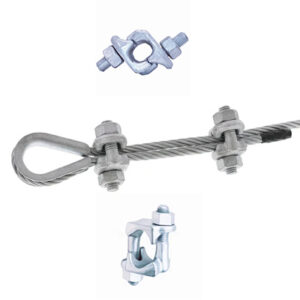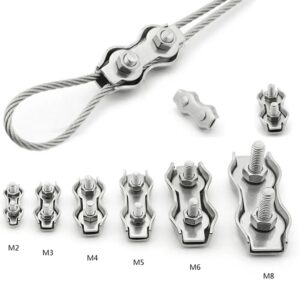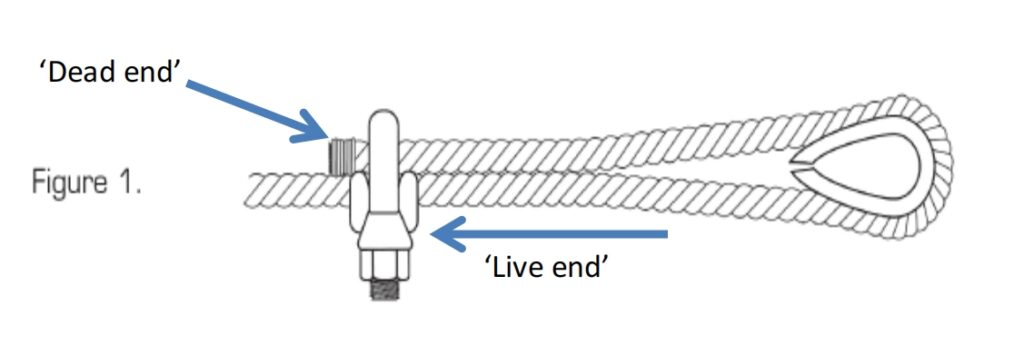Wire rope clips are essential components in various applications involving wire ropes, offering a reliable method for creating loops, securing ends, or joining multiple ropes together. Understanding the types of wire rope clips available and how to properly utilize them ensures safety and effectiveness in your projects. In this comprehensive guide, we’ll delve into the different types of wire rope clamps, their applications, and step-by-step instructions on how to use them.
If you want to find a professional wire rope clip supplier, you can contact us at H&F.
The Type of Wire Rope Clip
Wire rope clips come in various designs to accommodate different requirements and preferences. The three primary types are:
Wire Rope Clip

Wire rope clips are the most common type used for securing the ends of wire ropes or forming eye terminations. They typically consist of a u-bolt, saddle, and nuts. Galvanized steel clips are suitable for general-purpose applications, offering corrosion resistance and durability. On the other hand, stainless steel clips are ideal for environments where corrosion is a concern, such as marine or outdoor settings.
Fist Grip Clamps

Fist grip clamps feature a unique design with a malleable iron body and two hex nuts. These clamps provide a secure grip on the wire rope without causing damage, making them suitable for applications where the rope may need to be re-tensioned or adjusted frequently.
Duplex Wire Rope Clip

Duplex wire rope clips are similar in design to standard wire rope clips but feature two saddle pieces instead of one. This design allows for a more balanced distribution of load across the clip, making it suitable for heavy-duty applications or when a higher level of security is required.
How to Use Wire Rope Clip
Using a wire rope clip requires careful attention to detail to ensure proper installation and reliable performance. Follow these steps:
1. Select the Correct Size: Choose a wire rope clip that matches the diameter of your wire rope. Using an undersized or oversized clip can compromise the integrity of the connection.
2. Prepare the Wire Rope: Determine the desired length of the loop or termination and mark the wire rope accordingly. If forming an eye termination, ensure that the ends of the rope are neatly trimmed to prevent fraying.
3. Position the Clip: Place the wire rope clip over the rope, ensuring that the saddle sits on the “live” (short) end of the rope and the “dead” (long) end extends beyond the u-bolt.
notice: never apply the saddle of the clip to the dead end of the rope!

4. Tighten the Nuts: Thread the nuts onto the u-bolt and tighten them evenly using a wrench. Alternate between the nuts to ensure a uniform clamping force.

5. Check the Installation: After tightening the nuts, inspect the wire rope clip to ensure that it is properly seated and secure. Verify that the u-bolt makes full contact with the rope and that there are no gaps between the components.

6. Apply Load Gradually: Once the wire rope clip is installed, apply load gradually to the rope and monitor for any signs of slippage or deformation. Re-tighten the nuts if necessary to maintain proper tension.
7. Regular Inspection: Periodically inspect the wire rope clip for signs of wear, corrosion, or loosening. Replace any damaged or worn components to maintain the integrity of the connection.
Conclusion about Using Wire Rope Clip
Wire rope clips are versatile and reliable components for securing wire ropes in a wide range of applications. Whether you’re creating eye terminations, joining ropes together, or forming loops, understanding the different types of wire rope clips and how to properly use them is essential for ensuring safety and performance. By selecting the appropriate clip, following proper installation procedures, and conducting regular inspections, you can maintain secure connections and achieve optimal results in your projects.
FAQs about Using Wire Rope Clip
1. How do I determine the correct size of wire rope clip to use?
To determine the correct size of wire rope clip, match it to the diameter of your wire rope. Refer to manufacturer specifications or guidelines for sizing recommendations.
2. Can I reuse wire rope clips after they’ve been installed?
While it is possible to reuse wire rope clips, it is generally recommended to replace them with new ones to ensure the integrity of the connection, especially in critical or high-load applications.
3. Are there any safety precautions I should take when using wire rope clips?
Always wear appropriate personal protective equipment, such as gloves and eye protection, when handling wire rope and wire rope clips. Additionally, follow proper installation procedures to prevent accidents or injuries.
4. Can I use wire rope clips for overhead lifting applications?
Wire rope clips are not recommended for overhead lifting applications where the safety of personnel or equipment is at risk. Instead, use specialized hardware designed specifically for lifting purposes, such as wire rope thimbles and swage sleeves.
5. How do I know if a wire rope clip is installed correctly?
A properly installed wire rope clip should have the u-bolt fully seated on the rope with the nuts tightened evenly to provide a secure grip. Inspect the installation for any signs of slippage, deformation, or gaps between components.
6. Can I use wire rope clips with different types of wire rope materials?
Wire rope clips are suitable for use with various types of wire rope materials, including galvanized steel, stainless steel, and synthetic ropes. Ensure that the clip is compatible with the specific material and application requirements.
7. What is the recommended torque for tightening wire rope clip nuts?
Refer to manufacturer recommendations or guidelines for the recommended torque values when tightening wire rope clip nuts. Over-tightening can cause damage to the rope or clip, while under-tightening may result in slippage or failure.
8. How do I prevent corrosion on wire rope clips in outdoor or marine environments?
Choose wire rope clips made from corrosion-resistant materials, such as stainless steel, and apply appropriate protective coatings or treatments to prolong their lifespan in harsh environments.
9. Can I use wire rope clips to repair damaged wire ropes?
Wire rope clips may be used for temporary repairs on damaged wire ropes, but it is recommended to replace the damaged sections or ropes entirely to maintain safety and reliability.
10. Are there any alternatives to wire rope clips for securing wire ropes?
Alternatives to wire rope clips include swage fittings, mechanical splices, and wire rope sleeves, each offering unique advantages depending on the application requirements. Consult with a qualified engineer or specialist to determine the most suitable solution for your needs.




